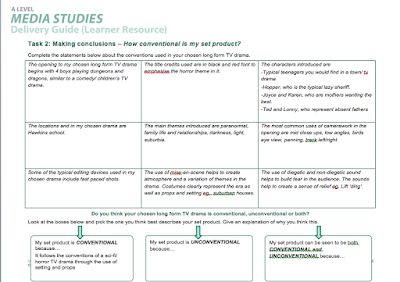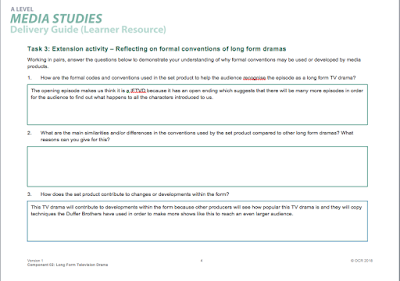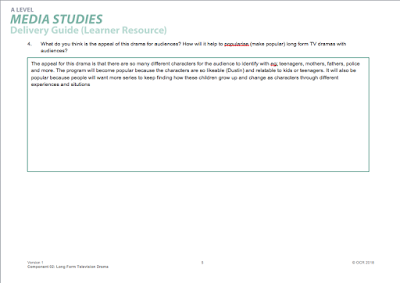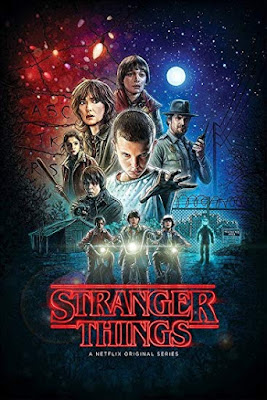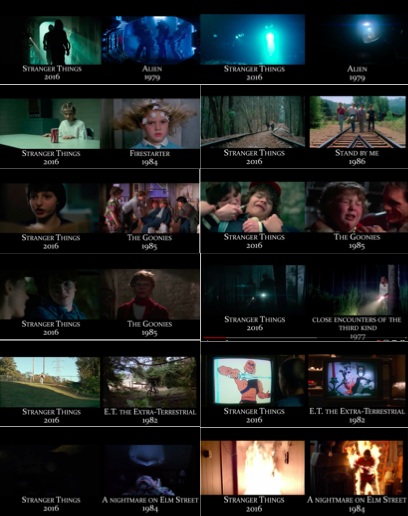How are
different social groups represented in the sequence you have analysed?
What role
does the use of media language, signs and signifiers have in constructing and
presenting these representations as real?
Make
a plan, go through the doc link and see what other students wrote for their
scenes, take notes.
Your
response must:
1.
Answer the question.
2.
Use key terms learned to date.
3.
Give a range of examples from the sequence to support your ideas. THIS IS THE
AREA YOU TEND TO LOSE MOST MARKS IN - CAMERA, EDITING, MES, SOUND
How to write Essay (Paragraph)
Point (fragmented open ended)
Example (boy missing and find 11 in rain)
Specific
Analysis (camera shot and editing, mise en scene
textual analysis)
Theory/ Terminology
Answer the question
In the TV Drama Stranger Things there are many
representations featured throughout. One of the main representations in the
storyline are teenagers and the different types. There are two different types
of teens one being the pre- teens, who are Mike, Will, Dustin and Lucas and are represented as the stereotypical nerdy, excited, pre- pubescent youths. We can
imply this because throughout the first episode, before Will goes missing, they
are all playing a board game getting heavily excited and enthusiastic about
being together. This shows how much they enjoy hanging out with their friends
and than be with their families just like the stereotypical young teen. We can
also know they are enjoying hanging out with each other by their facial
expressions and the close ups used by the camera to show their faces lighting
up with interest after every game movement. Concentration was another
expression on the boys faces suggesting they had a serious side to them making
them all very similar and with a close friendship. The teenage representation
is shown again through their use of language when they shout at one another the
word “pussy”, which is a word often used when throwing a insult and potentially
showing power. By using this term, they show their ages because ‘pussy’ is most
commonly used by young teens to show power of an opinion. This reinforces the audience how
close and honest friends they are. When Mike’s mother tells them to stop
playing later on in the scene, they are represented as a stereotypical grumpy
teen. This shows that when told what to do the boys moan are not happy due to
their age and the fact they are having fun hanging out.
The other type of teens represented are the older, more
mature ones showed through Nancy and Steve. Nancy is represented as the typical
‘girl next door’, unpopular high school girl who is always studying and always wants to make her grades. This is
shown through her fashion taste, wearing long skirts and high necks, being
represented as a teen who is well dressed and cares about her appearance. Its is also shown by the slow panning
of the camera on her body in order to show off her 80’s styled clothes and her innocent face. However Steve is the complete opposite ‘bad boy’ rebellious
teen, who in the storyline is trying to get with Nancy. He is represented as
this through his clothing choice; roll necks, clear up, gelled back hair and a repeated
smirk throughout the first episode. Steve is represented as a ‘trouble maker’
teen because in the narrative he distracts Nancy from studying and is a bad
influence on her. This is a stereotypical real representation of teens because
many incidents like this happen all the time within the youth making the
characters more realistic to the audience.
The authority in the town is another representation featured
in the drama and is through the Sheriff. He is represented as the typical lazy
sheriff who sleeps, smokes and gives off a laid back persona. This is because
in one of the opening scenes the camera slowly rises and it shows the sheriff laying
on the sofa with mess all over his house and being late for work. This instantly
makes the character seem real as he fits the stereotypical lazy, unorganised sheriff
making the audience feel like they know him. The lighting also helps represent
him because it is dull and the whether looks miserable. However due to the fact
its fragmented throughout the episode, our opinion changes about him and we
find out he lost his daughter changing his representation to a more softer,
caring character. This makes the audience feel sympathy for him and shows the
series may have more to offer and find out.

